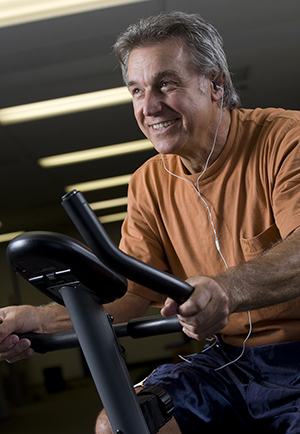After Knee Arthroscopy
After surgery, your joint may be swollen, painful, and stiff. Your recovery time will depend on what was done. Your surgeon will tell you when to resume activity and weight-bearing. If you had meniscal cartilage or loose bodies removed, you may be told to bear weight early on. You may be told to ride an exercise bike to restore your knee's motion and strength. After ACL repair, don't pivot or make sudden moves.
 |
| You may be told to ride an exercise bike. |
At home
Follow your surgeon’s guidelines for healing:
-
Raise (elevate) your knee as much as possible and ice your knee for 20 minutes at a time. Then allow at least 20 minutes before the next icing session. To make an ice pack, put ice cubes in a plastic bag that seals at the top. Wrap the bag in a thin towel or cloth. Don’t put ice or an ice pack directly on the skin.
-
Limit weight-bearing, if advised to do so. Your surgeon will tell you how much weight to put on your knee. Physical therapy may be prescribed.
-
Keep your knee bandaged according to your surgeon's instructions.
-
Your surgeon will tell you when you can shower or bathe. When you shower, wrap your knee with plastic to keep it dry.
-
Take pain medicine as directed. You may be on a combination of medicines, such as opioids, non-steroidal anti-inflammatory drugs (NSAIDs), and local anesthesia (called a "block"). Some pain is normal. Your healthcare team will help you know what is expected.
-
Follow your surgeon's instructions on taking medicine, like aspirin, to decrease the risk of blood clots.
-
Your surgeon will let you know when you can drive or operate machinery. This may be between 1 to 3 weeks.
Your checklist
The checklist below helps remind you what to do after knee arthroscopy.
☐ Schedule your first follow-up visit for 5 to 7 days after surgery, or as directed by your surgeon.
☐ Take care of your incision, and bathe as directed.
☐ Complete your physical therapy program.
☐ Talk with your surgeon about activities you can do right away and those that need to wait.
Call 911
Call 911 if you have any of these:
-
Chest pain
-
Shortness of breath or feeling you can't get enough air
-
Feeling lightheaded, faint, or dizzy
When to call your healthcare provider
Contact your healthcare provider right away if any of these occur:
-
Fever of 100.4°F (38°C) or above, or as directed by your provider
-
Chills
-
Lasting warmth or redness around the knee
-
Lasting or increased pain
-
Severe swelling in your knee
-
Increasing pain, swelling, or redness in your calf muscle
-
Knee stiffness that gets worse.
Online Medical Reviewer:
Rahul Banerjee MD
Online Medical Reviewer:
Raymond Turley Jr PA-C
Online Medical Reviewer:
Rita Sather RN
Date Last Reviewed:
4/1/2024
© 2000-2025 The StayWell Company, LLC. All rights reserved. This information is not intended as a substitute for professional medical care. Always follow your healthcare professional's instructions.